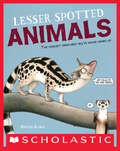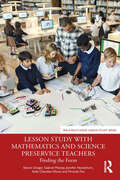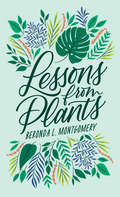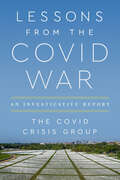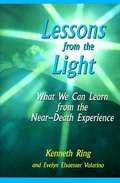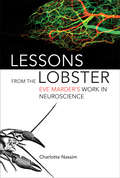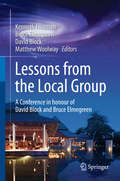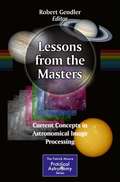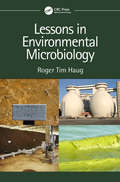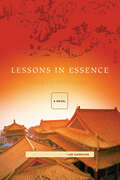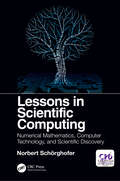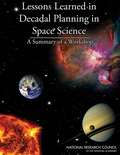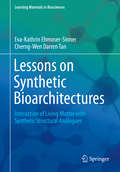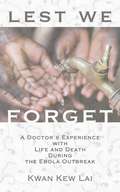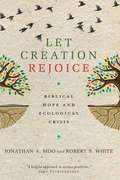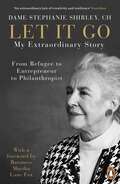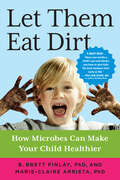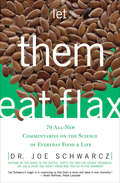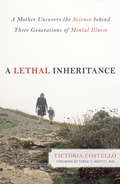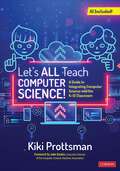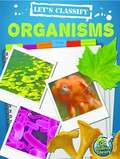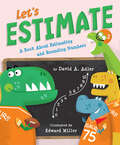- Table View
- List View
The Lesser-Known Albert Einstein: Without a Trace of Relativity (History of Physics)
by Luis Navarro VeguillasThis book highlights the numerous important contributions that Einstein made to physics—aside from his relativity theories—and places each of his achievements in the corresponding context, referring en route to the original sources.There are very few publications devoted to Einstein's work outside of relativity. This book aims to fill the gap by exploring the scope of Einstein's contributions on topics including molecular forces, thermostatistics, the photoelectric effect, Brownian motion, molecular currents, critical opalescence, energy quanta, dual structure of radiation, introduction of the photon, and the formulation of the first quantum statistics.The book pays special attention to Einstein's scepticism toward certain ideas that came to light alongside Schrödinger's first formulation of wave mechanics in 1926, also addressing his doubts regarding the probabilistic interpretation of the quantum formalism, an issue closely connected with the hidden variable theories and their implications. The author discusses the early hidden variable theories, whose appearance was largely a result of Einstein's criticism of the orthodox interpretation of quantum formalism.Finally, in an appendix, the author explores the controversy about the possible contribution that Mileva Marić, Albert Einstein's first wife, may have made to some of her husband's main scientific achievements.
Lesser Spotted Animals
by Martin BrownA hilarious, fact-tastic picture book about the coolest creatures you've never heard of, from the illustrator of the internationally bestselling Horrible Histories.Bison? They're banned! Tigers? Taboo! Say good-bye to the gnu, cheerio to the cheetah, and peace to the panda.The world of Lesser Spotted Animals STARTS HERE!Find out all about the amazing animals you need to know but never get to see, from the numbat to the zorilla, and everything in between. A non-fiction picture book with attitude, Martin Brown's Lesser Spotted Animals combines the humor and verve of books like Dragons Love Tacos and Please Mr. Panda with the informative breadth and gorgeous presentation of non-fiction from Steve Jenkins, Diana Aston, and Jenny Broom.
Lesson Study with Mathematics and Science Preservice Teachers: Finding the Form (WALS-Routledge Lesson Study Series)
by Sharon Dotger Gabriel Matney Jennifer Heckathorn Kelly Chandler-Olcott Miranda FoxThis insightful volume offers an overview of the fundamentals of lesson student practice in US teacher education as well as examples from math and science teacher educators using lesson study in their local contexts. The number of teacher educators using lesson study with preservice teachers is small but growing. This book is aimed at teacher educators who may want to try lesson study in university contexts without the challenge of translating the practice from the K-12 context on their own. In this volume, lesson study is broadly overviewed, attention is given to its constituent steps, and examples of lesson study in preservice contexts are shared. Given the broad array of teacher education program designs, numerous contingencies guide teacher educators in their implementation of lesson study, given their contextual affordances and limitations. The lesson study descriptions and cases in this book will support teacher educators and scholars across subject specialities and geographic lines, as they seek instructional frameworks to advance their pedagogical goals.
Lessons from Plants
by Beronda L. MontgomeryAn exploration of how plant behavior and adaptation offer valuable insights for human thriving. We know that plants are important. They maintain the atmosphere by absorbing carbon dioxide and producing oxygen. They nourish other living organisms and supply psychological benefits to humans as well, improving our moods and beautifying the landscape around us. But plants don’t just passively provide. They also take action. Beronda L. Montgomery explores the vigorous, creative lives of organisms often treated as static and predictable. In fact, plants are masters of adaptation. They “know” what or who they are, and they use this knowledge to make a way in the world. Plants experience a kind of sensation that does not require eyes or ears. They distinguish kin, friend, and foe, and they are able to respond to ecological competition despite lacking the capacity of fight-or-flight. Plants are even capable of transformative behaviors that allow them to maximize their chances of survival in a dynamic and sometimes unfriendly environment. Lessons from Plants enters into the depth of botanic experience and shows how we might improve human society by better appreciating not just what plants give us but also how they achieve their own purposes. What would it mean to learn from these organisms, to become more aware of our environments and to adapt to our own worlds by calling on perception and awareness rather than reason? Montgomery’s meditative study puts before us a question with the power to reframe the way we live: What would a plant do?
Lessons from the Covid War: An Investigative Report
by Covid Crisis GroupThis powerful report on what went wrong—and right—with America&’s Covid response, from a team of 34 experts, shows how Americans faced the worst peacetime catastrophe of modern times Our national leaders have drifted into treating the pandemic as though it were an unavoidable natural catastrophe, repeating a depressing cycle of panic followed by neglect. So a remarkable group of practitioners and scholars from many backgrounds came together determined to discover and learn lessons from this latest world war. Lessons from the Covid War is plain-spoken and clear sighted. It cuts through the enormous jumble of information to make some sense of it all and answer: What just happened to us, and why? And crucially, how, next time, could we do better? Because there will be a next time. The Covid war showed Americans that their wondrous scientific knowledge had run far ahead of their organized ability to apply it in practice. Improvising to fight this war, many Americans displayed ingenuity and dedication. But they struggled with systems that made success difficult and failure easy. This book shows how Americans can come together, learn hard truths, build on what worked, and prepare for global emergencies to come. A joint effort from: Danielle Allen • John M. Barry • John Bridgeland • Michael Callahan • Nicholas A. Christakis • Doug Criscitello • Charity Dean • Victor Dzau • Gary Edson • Ezekiel Emanuel • Ruth Faden • Baruch Fischhoff • Margaret &“Peggy&” Hamburg • Melissa Harvey • Richard Hatchett • David Heymann • Kendall Hoyt • Andrew Kilianski • James Lawler • Alexander J. Lazar • James Le Duc • Marc Lipsitch • Anup Malani • Monique K. Mansoura • Mark McClellan • Carter Mecher • Michael Osterholm • David A. Relman • Robert Rodriguez • Carl Schramm • Emily Silverman • Kristin Urquiza • Rajeev Venkayya • Philip Zelikow
Lessons from the Light
by Kenneth Ring Evelyn Elsaesser ValarinoWhile providing many accounts of near-death experiences (NDEs) from men, women, and children of all ages and backgrounds, Lessons from the Light is much more than just an inspiring collection of NDEs. In Lessons near-death expert Kenneth Ring extracts the pure gold of the NDE and with a beautiful balance of sound research and human insight reveals the practical wisdom held within these experiences. This material includes reports of out-of-body experiences, children's NDEs, blind people gaining sight during NDE episodes.
Lessons from the Lobster: Eve Marder's Work in Neuroscience (The\mit Press Ser.)
by Charlotte NassimHow forty years of research on thirty neurons in the stomach of a lobster has yielded valuable insights for the study of the human brain.Neuroscientist Eve Marder has spent forty years studying thirty neurons on the stomach of a lobster. Her focus on this tiny network of cells has yielded valuable insights into the much more complex workings of the human brain; she has become a leading voice in neuroscience. In Lessons from the Lobster, Charlotte Nassim describes Marder's work and its significance accessibly and engagingly, tracing the evolution of a supremely gifted scientist's ideas. From the lobster's digestion to human thought is very big leap indeed. Our brains selectively recruit networks from about ninety billion available neurons; the connections are extremely complex. Nevertheless, as Nassim explains, Marder's study of a microscopic knot of stomatogastric neurons in lobsters and crabs, a small network with a countable number of neurons, has laid vital foundations for current brain research projects. Marder's approach is as intuitive as it is analytic, but always firmly anchored to data. Every scrap of information is a pointer for Marder; her discoveries depend on her own creative thinking as much as her laboratory's findings. Nassim describes Marder's important findings on neuromodulation, the secrets of neuronal networks, and homeostasis. Her recognition of the importance of animal-to-animal variability has influenced research methods everywhere.Marder has run her laboratory at Brandeis University since 1978. She was President of the Society for Neuroscience in 2008 and she is the recipient of numerous awards, including the 2016 Kavli Award in Neuroscience and the 2013 Gruber Prize in Neuroscience. Research that reaches the headlines often depends on technical fireworks, and especially on spectacular images. Marder's work seldom fits that pattern, but this book demonstrates that a brilliant scientist working carefully and thoughtfully can produce groundbreaking results.
Lessons from the Local Group
by Kenneth Freeman Bruce Elmegreen David Block Matthew WoolwayOur understanding of galaxy formation comes mostly from two sources: sensitive observations at high angular resolution of the high-redshift Universe, where galaxies are observed to be forming, and detailed observations of individual stars and clouds in the Local Group, where telltale remnants from its formative time remain and similar processes operate at a low level today. The current conference focusses on key aspects of the Local Group, composed of the Milky Way, Andromeda and Triangulum Spiral Galaxies, the Large and Small Magellanic Cloud galaxies, numerous dwarf and irregular galaxies, and intergalactic gas. Topics include the halo and thick disk of the Milky Way with its first stars and stellar streams; the Milky Way bar, bulge and outer edge; interstellar dust and turbulence; star formation processes and stellar scattering in spiral arms; views through the infrared Eyes of the Spitzer Space Telescope; globular clusters; the Local Gould Belt; stellar metallicities and elemental abundances; the environment and black hole in the Milky Way nucleus; orbits of the Magellanic Clouds and galaxy dwarfs; interstellar dust and turbulence; the outer disks and halos of the Andromeda and Triangulum galaxies; ripples from a collision in Andromeda; and arcs of carbon stars in the Triangulum and intergalactic clouds. This volume also discusses surveys of planetary nebulae, galaxy morphology at low and high redshift, cosmic evolution of star and galaxy formation and gas accretion, Lyman alpha emitting galaxies, ultra-low surface brightness imaging, and more. Readers are given a clear and comprehensive view of this wide range of topics written by specialists in each field. This is the proceedings of an International Conference at the Seychelles archipelago in May 2014, on the occasion of the 60th birthday of David Block and the millionth (base two) birthday of Bruce Elmegreen.
Lessons from the Masters: Current Concepts in Astronomical Image Processing
by Robert GendlerThere are currently thousands of amateur astronomers around the world engaged in astrophotography at a sophisticated level. Their ranks far outnumber professional astronomers doing the same and their contributions both technically and artistically are the dominant drivers of progress in the field today. This book is a unique collaboration of individuals world-renowned in their particular area and covers in detail each of the major sub-disciplines of astrophotography. This approach offers the reader the greatest opportunity to learn the most current information and the latest techniques directly from the foremost innovators in the field today. "Lessons from the Masters" includes a brilliant body of recognized leaders in astronomical imaging, assembled by Robert Gendler, who delivers the most current, sophisticated and useful information on digital enhancement techniques in astrophotography available today. Each chapter focuses on a particular technique, but the book as a whole covers all types of astronomical image processing, including processing of events such as eclipses, using DSLRs, and deep-sky, planetary, widefield, and high resolution astronomical image processing. Recognized contributors include deep-sky experts such as Jay GaBany, Tony Hallas, and Ken Crawford, high-resolution planetary expert Damian Peach, and the founder of TWAN (The World at Night) Babak A. Tafreshi. A large number of illustrations (150, 75 in color) present the challenges and accomplishments involved in the processing of astronomical images by enthusiasts.
Lessons in Environmental Microbiology
by Roger Tim HaugLessons in Environmental Microbiology provides an understanding of the microbial processes used in the environmental engineering and science fields. It examines both basic theory as well as the latest advancements in practical applications, including nutrient removal and recovery, methanogenesis, suspended growth bioreactors, and more. The information is presented in a very user-friendly manner; it is not assumed that readers are already experts in the field. It also offers a brief history of how microbiology relates to sanitary practice, and examines the lessons learned from the great epidemics of the past. Numerous worked example problems are presented in every chapter.
Lessons in Essence: A Novel
by Dana StandridgeImbued with the tension of Taipei and the beauty of mountain seclusion, Lessons in Essence uncovers timeless human truths in the crises faced by an honest and vulnerable manTeacher Li is a grumbling Taiwanese master of ancient Chinese arts who suffers constant nightmares about a military takeover of Taiwan by China. His family is in New York seeking U.S. citizenship when Teacher Li has an almost accidental sexual encounter with a student. Knowing everything, his wife returns to Taipei. Miserable, but finding no solace in the city, Teacher Li retreats to the mountains like the Zen hermits of old to write a book about aesthetics. But the purity he seeks is elusive even in mountain exile—he finds a rotting house for shelter, and for company the contrary Dr. Gao and his dropout student lover. Their cynicism juxtaposes Teacher Li's innocence as New York is attacked on September 11, Taiwan's president is shot in an assassination attempt, and the poles of the world seem to shift.With keen insight into human nature, subjects as diverse as erotic paintings, Virginia Woolf's punctuation, and the casual savagery of children, Dana Standridge delivers a powerful story from a complex time in history.
Lessons in Scientific Computing: Numerical Mathematics, Computer Technology, and Scientific Discovery
by Norbert Schorghofer<p>Taking an interdisciplinary approach, this new book provides a modern introduction to scientific computing, exploring numerical methods, computer technology, and their interconnections, which are treated with the goal of facilitating scientific research across all disciplines. <p>Each chapter provides an insightful lesson and viewpoints from several subject areas are often compounded within a single chapter. Written with an eye on usefulness, longevity, and breadth, Lessons in Scientific Computing will serve as a "one stop shop" for students taking a unified course in scientific computing, or seeking a single cohesive text spanning multiple courses. <p>Features: <p> <li>Provides a unique combination of numerical analysis, computer programming, and computer hardware in a single text <li>Includes essential topics such as numerical methods, approximation theory, parallel computing, algorithms, and examples of computational discoveries in science <li>Written in a clear and engaging style <li>Not wedded to a specific programming language</li> </p>
Lessons Learned in Decadal Planning in Space Science
by David H. Smith Board on Physics and Astronomy Division on Engineering and Physical Sciences Space Studies Board National Research Council Lewis GroswaldThe National Research Council (NRC) has been conducting decadal surveys in the Earth and space sciences since 1964, and released the latest five surveys in the past 5 years, four of which were only completed in the past 3 years. Lessons Learned in Decadal Planning in Space Science is the summary of a workshop held in response to unforseen challenges that arose in the implementation of the recommendations of the decadal surveys. This report takes a closer look at the decadal survey process and how to improve this essential tool for strategic planning in the Earth and space sciences. Workshop moderators, panelists, and participants lifted up the hood on the decadal survey process and scrutinized every element of the decadal surveys to determine what lessons can be gleaned from recent experiences and applied to the design and execution of future decadal surveys.
Lessons on Synthetic Bioarchitectures: Interaction Of Living Matter With Synthetic Structural Analogues (Learning Materials in Biosciences)
by Cherng-Wen Darren Tan Eva-Kathrin Ehmoser-SinnerThis textbook discusses the new relationship between artificial, synthetic material and living matter, and presents defined examples of approaches aiming for the creation of artificial cells. It also offers insights into the world of synthetic biology from its origins to the present day, showing what is currently possible in this discipline. Furthermore, it examines the ethical concerns and potential threats posed by this new field. The textbook is based on a lecture of the same title, held for master’s students at the University of Natural Resources and Life Sciences (BOKU), Vienna, and is primarily intended for students of synthetic biology, biotechnology and bioengineering. It is also of interest to research scientists from other disciplines wishing to learn more about the state of the art of synthetic biology and its future.
Lest We Forget: A Doctor's Experience with Life and Death During the Ebola Outbreak
by Kwan Kew LaiIn 2014 after fighting through yards of bureaucratic red tape, leaving her family, and putting her own health at risk in order to help suffering strangers, Kwan Kew Lai finally arrived in Africa to volunteer as an infectious disease specialist in the heart of the largest Ebola outbreak in history. What she found was not only blistering heat, inhospitable working conditions, and deadly, unrelenting illness, but hope, resilience, and incredible courage. Lest We Forget chronicles the harrowing and inspiring time spent serving on the front lines of the ongoing Ebola outbreak—the complicated Personal Protective Equipment, the chlorine-scented air, the tropical heat, and the heartbreaking difficulties of treating patients she could not touch. Dr. Lai interweaves original diary entries to create a gripping narrative about life, death, and human relationships that will leave no reader unmoved. Lest We Forget exposes the raw brutality of Ebola, as well as the chaotic nature of the undersupplied and understaffed health infrastructure in the developing world. At once a memoir of triumphs and failures and a memorial, this book will ensure that the victims of Ebola and the fighters who sought to heal them will not be forgotten.
Let Creation Rejoice: Biblical Hope and Ecological Crisis
by Jonathan A. Moo Robert S. White"Let all creation rejoice before the LORD, for he comes." Psalm 96:13 The Bible is bathed with images of God caring for his creation in all its complexity. Yet in the face of climate change and other environmental trends, philosophers, filmmakers, environmentalists, politicians and senior scientists increasingly resort to apocalyptic rhetoric to warn us that a so-called perfect storm of factors threatens the future of life on earth. Jonathan Moo and Robert White ask, "Do these dire predictions amount to nothing more than ideological scaremongering, perhaps hyped-up for political or personal ends? Or are there good reasons for thinking that we may indeed be facing a crisis unprecedented in its scale and in the severity of its effects?" The authors encourage us to assess the evidence for ourselves. Their own conclusion is that there is in fact plenty of cause for concern. Climate change, they suggest, is potentially the most far-reaching threat that our planet faces in the coming decades, and also the most publicized. But there is a wide range of much more obvious, interrelated and damaging effects that a growing number of people, consuming more and more, are having on the planet upon which we all depend. Yet if the Christian gospel fundamentally reorients us in our relationship to God and his world, then there ought to be something radically distinctive about our attitude and approach to such threats. In short, there ought to be a place for hope. And there ought to be a place for Christians to participate in that hope. Moo and White therefore reflect on the difference the Bible's vision of the future of all of creation makes. Why should creation rejoice? Because God loves and cares the world he made.
Let It Go: My Extraordinary Story - From Refugee to Entrepreneur to Philanthropist
by Dame Stephanie Shirley CH Richard AskwithA moving memoir from a woman who made a fortune in a man's world and then gave it all away...soon to be turned into a filmIn 1962, Stephanie 'Steve' Shirley created a software company when the concept of software barely existed. Freelance Programmers employed women to work on complex projects such as Concorde's black box recorder from the comfort of their own home. Shirley empowered a generation of women in technology, giving them unheard of freedom to choose their own hours and manage their own workloads. The business thrived and Shirley gradually transferred ownership to her staff, creating 70 millionaires in the process.Let It Go explores Shirley's trail blazing career as an entrepreneur but it also charts her incredible personal story - her dramatic arrival in England as an unaccompanied Kindertransport refugee during World War Two and the tragic loss of her only child who suffered severely from Autism.Today, Dame Stephanie Shirley is one of Britain's leading philanthropists, devoting most of her time, energy and wealth to charities that are close to her heart. In Let It Go, Shirley tells her inspirational story and explains why giving her wealth away - letting it go - has brought her infinitely more happiness and fulfilment than acquiring it in the first place.Co-written with Richard Askwith, the former Executive Editor of The Independent and the award-winning author of seven books in his own name, including biographies of Emil Zátopek and Lata Brandisová.'An extraordinary tale of creativity and resilience' - Guardian'This engrossing story of an extraordinary life is filled with lessons in what it means to be human' - Financial Times
Let Them Eat Dirt: How Microbes Can Make Your Child Healthier
by Dr B. Brett Finlay Dr Marie-Claire Arrieta“A must-read . . . Takes you inside a child’s gut and shows you how to give kids the best immune start early in life.” —William Sears, MD, coauthor of The Baby BookLike the culture-changing Last Child in the Woods, here is the first parenting book to apply the latest cutting-edge scientific research about the human microbiome to the way we raise our children. In the two hundred years since we discovered that microbes cause infectious diseases, we’ve battled to keep them at bay. But a recent explosion of scientific knowledge has led to undeniable evidence that early exposure to these organisms is beneficial to a child’s well-being. Our modern lifestyle, with its emphasis on hyper-cleanliness, is taking a toll on children’s lifelong health. In this engaging and important book, microbiologists Brett Finlay and Marie-Claire Arrieta explain how the trillions of microbes that live in and on our bodies influence childhood development; why an imbalance of those microbes can lead to obesity, diabetes, and asthma, among other chronic conditions; and what parents can do--from conception on--to positively affect their own behaviors and those of their children. They describe how natural childbirth, breastfeeding, and solid foods influence children’s microbiota. They also offer practical advice on matters such as whether to sterilize food implements for babies, the use of antibiotics, the safety of vaccines, and why having pets is a good idea. Forward-thinking and revelatory, Let Them Eat Dirt is an essential book in helping us to nurture stronger, more resilient, happy, and healthy kids.
Let Them Eat Flax!: 70 All-New Commentaries on the Science of Everyday Food & Life
by Joe SchwarczThe bestselling popular science author of A Grain of Salt serves up “interesting factoids about the way that science has helped shape our everyday lives” (Joe Culotti, PhD, professor of molecular and medical genetics, University of Toronto). In Let Them Eat Flax, award-winning author Dr. Joe Schwarcz continues his crusade against purveyors of poppycock as he investigates the surprising and sometimes sinister science of everyday food and life. What difference does an atom make? It could mean life or death! Get the lowdown on oxygenated water, the healing powers of prayer, and the health benefits of chocolate. Could there be a link between McGill University and Jack the Ripper? Find out how cinnamon helps to counter high cholesterol, and learn just how sweet sugar alternatives can be. In the tradition of Schwarcz’s five previous bestsellers, Let Them Eat Flax fries scientific baloney with humor, wit, and information. From food poisoning to the secret of the Stradivarius violin, fertilizers to spontaneous human combustion, Schwarcz investigates explosive subjects and delivers the unbiased, scientific facts readers need to make informed decisions in their everyday lives. “Dr. Schwarcz . . . has a knack for translating science into a language that anyone can understand and actually enjoy.” —Toronto Sun “Joe Schwarcz’s magic is in convincing us that there is verve and value in real chemistry.” —Roald Hoffman, Nobel Laureate “Dr. Joe blends intelligence, scientific expertise, critical thinking, humor, and a healthy dose of skepticism in a prescription for good reading.” —Leon Jaroff, former senior editor, Time magazine, and founder of Discover magazine
A Lethal Inheritance
by Victoria CostelloEvery family has secrets; only some secrets are lethal. In Victoria Costello's family mental illness had been given many names over at least four generations until this inherited conspiracy of silence finally endangered the youngest members of the family, her children. In this riveting story--part memoir, detective story, and scientific investigation--the author recounts how the mental unraveling of her seventeen-year-old son Alex compelled her to look back into family history for clues to his condition. Eventually she tied Alex's descent into hallucinations and months of shoeless wandering on the streets of Los Angeles to his great grandfather's suicide on a New York City railroad track in 1913. But this insight brought no quick relief. Within two years of Alex's diagnosis of paranoid schizophrenia, both she and her youngest son succumbed to two different mental disorders: major depression and anxiety disorder. Costello depicts her struggle to get the best possible mental health care for her sons and herself, treatment that ultimately brings each of them to full recovery. In the process, she discovers new science that explains how clusters of mental illness traverse family generations. Artfully weaving the scientific into the personal, Costello takes a journey to the far reaches of neuroscience and reports back on the startling findings it is yielding about the complex interplay between genes and environment that drives mental illness, and what it now tells us about how parents can trump a lethal inheritance. She shares the results of long-term U.K. and European family studies identifying the earliest signs of mental illnesses that can be passed on from grandparents to parents and grandchildren. She tracks ongoing clinical trials to reverse the courses of these diseases through early intervention with the latest evidence-based treatments and offers brain-healthy choices individuals and families can make to prevent mental illness--freeing future generations to live healthier, happier lives.
Let′s All Teach Computer Science!: A Guide to Integrating Computer Science Into the K-12 Classroom
by Kiki ProttsmanYou belong in this world of computer science education—and because of you, adults of the future will understand how to responsibly participate in high-tech environments with confidence. Districts, cities, and states are moving toward computer science requirements for all K-12 classrooms, even in courses that were not previously associated with technology. These new requirements leave many teachers feeling anxious and unprepared when it comes to integrating computer science into existing curriculum. This book is here to support educators in that shift by inviting them to explore computer science and coding in an approachable and unintimidating way. Let′s All Teach Computer Science: K-12 is a source of inspiration and empowerment for educators who are moving into this technological wonderland. Kiki Prottsman has more than 15 years of experience in computer science education, and her insight informs thoughtful discussions on promoting creativity, problem-solving, and collaboration in students. The book positions computer science in a way that supports other essential skills–such as reading, writing, and mathematics– by providing customizable frameworks that help to seamlessly integrate computer science into core subjects. This book: Provides powerful insights for creating innovative and inclusive learning environments Offers practical examples of integrating computer science into traditional subjects like math, history, art, and more Highlights the importance of addressing implicit biases and promoting computer science as an inclusive field for all students Includes insights on classroom technology and educational technology, as well as AI and its role in education Encourages educators to work together to nurture digital innovators while recognizing potential challenges and frustrations Let′s All Teach Computer Science is an essential guide that equips K-12 teachers with the knowledge and tools necessary to begin teaching computer science immediately–and does so in an enjoyable way, thanks to Prottsman’s friendly and playful style.
Let′s All Teach Computer Science!: A Guide to Integrating Computer Science Into the K-12 Classroom
by Kiki ProttsmanYou belong in this world of computer science education—and because of you, adults of the future will understand how to responsibly participate in high-tech environments with confidence. Districts, cities, and states are moving toward computer science requirements for all K-12 classrooms, even in courses that were not previously associated with technology. These new requirements leave many teachers feeling anxious and unprepared when it comes to integrating computer science into existing curriculum. This book is here to support educators in that shift by inviting them to explore computer science and coding in an approachable and unintimidating way. Let′s All Teach Computer Science: K-12 is a source of inspiration and empowerment for educators who are moving into this technological wonderland. Kiki Prottsman has more than 15 years of experience in computer science education, and her insight informs thoughtful discussions on promoting creativity, problem-solving, and collaboration in students. The book positions computer science in a way that supports other essential skills–such as reading, writing, and mathematics– by providing customizable frameworks that help to seamlessly integrate computer science into core subjects. This book: Provides powerful insights for creating innovative and inclusive learning environments Offers practical examples of integrating computer science into traditional subjects like math, history, art, and more Highlights the importance of addressing implicit biases and promoting computer science as an inclusive field for all students Includes insights on classroom technology and educational technology, as well as AI and its role in education Encourages educators to work together to nurture digital innovators while recognizing potential challenges and frustrations Let′s All Teach Computer Science is an essential guide that equips K-12 teachers with the knowledge and tools necessary to begin teaching computer science immediately–and does so in an enjoyable way, thanks to Prottsman’s friendly and playful style.
Let's Classify Organisms
by Kelli Hicks'Let's Classify Organisms' classifies living organisms into six kingdoms with great detail along with interesting facts for students.
Let's Drive, Henry Ford!
by Peter Roop Connie RoopHenry Ford is famous. He made many different kinds of cars. Do you know that Henry did not invent the car? Henry was born on a farm in Michigan. Do you know that wolves could be heard in the woods when Henry was born? Henry worked hard on the family farm. Do you know that Henry was determined to find a way not to do all of that hard work? Henry loved to fix broken watches. Do you know that Henry repaired his neighbors' watches for free? Henry loved to tinker with toys. Do you know why his brothers and sisters wouldn't let him play with their toys? Henry was fascinated by the power of steam. Do you know that Henry made a steam whistle to scare his sister? Henry liked to learn. Do you know that he never finished high school? Henry left his family's farm to work with machines. Do you know he ran one of Thomas Edison's first electricity plants in Detroit? Henry was fascinated with the idea of designing a horseless carriage. Did you know that other inventors succeeded before he did? Henry dreamed of building a car to carry people. Do you know that he made millions of cars, trucks, and tractors? Henry had many ideas. Do you know it was his idea to build cars quickly and inexpensively on an assembly line? The answers to these questions lie in who Henry Ford was as a child and as a young man. This book is about Henry Ford before he made history.
Let's Estimate: A Book About Estimating and Rounding Numbers
by David A. AdlerPartying dinos explain estimation in this entertaining introduction by a tried-and-true team of fun math book creators. How much pizza do you need for a dinosaur party? If you don't know exactly, you have to estimate! This lively introduction to the mathematical concept of estimation is straightforward and fun. With brilliant clarity, David A. Adler explains what an estimate is and the difference between estimating and rounding. Edward Miller's colorful and energetic artwork offers the perfect accompaniment to concise, engaging text. Filled with graspable examples and simple explanations, Let's Estimate will have kids estimating like pros!

